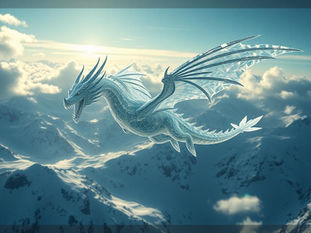
Is This AI Tool Better Than Midjourney for Design Work?
May 5
5 min read
0
6
0

Finding the right AI design tool can be tough. Most promise a lot but don't deliver great results. Recently, I discovered a platform that really stood out. It's called design.a, and it does some impressive things that might even make you look at Midjourney differently.
I was direct with the company from the start: I planned to share my honest opinion. They were supportive, which showed they believe in their product. They even offered to help me improve my prompts. This experience highlighted something important: having a good prompt is essential for good AI art, no matter which tool you use, including platforms like Midjourney.
First Look and Unique Features
Logging in, I immediately saw a print on demand section. This is not common and shows the platform's focus. Besides basic tasks like removing backgrounds, design.a offers a range of AI tools. The ones I found most useful and relevant include text to image and image to image generation. These work like you might expect, similar to Midjourney. But there are other tools too, like making images 3D and expanding image backgrounds.
I also tested a logo effect feature that turns a PNG image into materials like chrome. You can upload your own logo or name saved as a PNG. The tool lets you set how closely the AI should follow the original logo shape. A cool aspect is the option to export the result as an SVG file, which is a vector format. You can also turn the image into a 3D object if you wish. Need to fix small areas? There's an AI eraser. There's also a background removal tool.
After generating logo options, I got four choices. They looked pretty good. I could save one as an SVG (vector) or a PNG. Saving as a PNG lets you bring it into programs like Photoshop for further use in designs or artwork. You can also upscale images, making them larger and higher quality for printing or other projects.
Image to Image and Text to Image Power
One feature I was excited about is image to image. This lets you take a design you already have and use AI to change or enhance it. By uploading an image and adding a text prompt, the AI can give your design a totally new style. I tried changing a design into an "AI robot with lightning and clouds." You can adjust how much the AI sticks to your original image.
This feature is really helpful if you have a design start but want to see how AI could take it in a different direction, maybe adding more detail or changing the style. You can explore different AI styles too, like 'realistic.' The results were impressive, offering various versions you could enhance and upscale.
The background removal tool worked well on both generated images and uploaded ones. It quickly made the background transparent, which is helpful if you need to isolate an element for use in other designs or for print.
I also tested the text to image tool. Creating images from text prompts works much like Midjourney. I tried prompts for animals and robots. The results looked good, often avoiding strange details like extra teeth that I’ve seen in other AI models.
To get the most out of your AI design efforts, managing and organizing your generated images is important. A tool that helps automate these tasks can save significant time. Check out the [LINK url='https://www.titanxt.io/midjourneyautomator']Midjourney Automation Suite from TitanXT[/LINK] to see how you can streamline your design process.
Expanding Images and Using Results
The generative expand tool is useful for extending the edges of an image. If you have a cool AI image but parts are cut off, you can use this to generate more content around the borders automatically. You don't even need a prompt; the AI tries to fill it in based on the existing image. The results looked great, adding interesting foreground or background elements to the image. Upscaling these expanded images makes them ready for high-resolution use.
Using these AI-generated images with other tools like Photoshop works smoothly. You can bring in transparent PNGs and easily add backgrounds, filters, or textures. There's nothing wrong with using AI for design. Many stock photo sites now include AI images. It's part of how design is changing.
Design for Print on Demand
The print on demand section is a big plus, especially for people selling things like t-shirts. The "idea to design" workflow guides you. You can type in what you want for a t-shirt, like "vector T-shirt design says dragon slayer in bold vintage letters" and "a vector graphic of a knight fighting a dragon with a flaming sword."
The tool produced vector designs that looked ready for print. While some designs might need minor cleanup, especially around edges or background removal, the fact that you get a vector output is a major advantage. Vector files are easy to edit and scale in programs like Illustrator. This can really speed up the design process for print on demand sellers.
Pros and Cons of the Platform
Pros:
It's an all-in-one platform with many AI tools (text to image, image to image, background removal, vector export) similar to features found across different services like Midjourney or Adobe AI tools.
It has a focus on print on demand workflows, which is specific and helpful for that audience.
It's easy to sign up and start using quickly, even for people new to AI design tools.
Pricing is reasonable. There's a free tier with daily credits, and paid plans offer more credits or unlimited use for higher volumes. The cost is comparable to or less than some single-function AI platforms like Midjourney, while offering more tools.
It offers unique features like vector export (SVG) and specific logo effects.
Text generation within designs handled well, which is often a challenge for AI like Midjourney.
Cons:
You still need to learn how to write effective prompts to get the best results. This takes practice.
Sometimes, generating images took a little longer than expected. It wasn't excessively slow, but noticeable at times.
AI background removal tools, on this platform and others, might still need manual cleanup in external software like Photoshop for perfect results.
The pricing structure could be a con for some users depending on their credit needs.
Conclusion
Overall, design.a is a strong contender, especially if you're looking for an AI design tool that does more than just generate images from text, or if you work in print on demand. Its range of features in one place is very convenient.
While design.a offers many tools, managing a large volume of AI-generated images across different projects can become complex. Automating parts of your workflow can make a big difference. Discover how the [LINK url='https://www.titanxt.io/midjourneyautomator']Midjourney Automation Suite from TitanXT[/LINK] can help you organize, manage, and process your AI art more effectively.
If you're interested in trying design.a, you can sign up for free and get daily credits. It's worth exploring their different tools, especially the print on demand features and the ability to export vectors.






